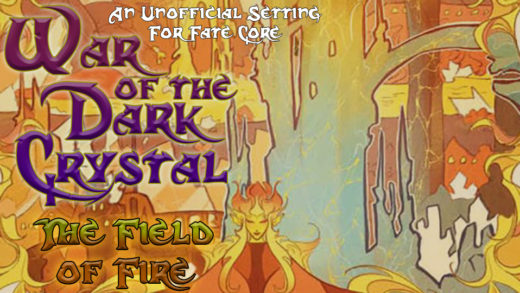Space Opera may often include fantastical elements but there are only a handful of RPGs that directly lift the standard fantasy genre and plop it on to the deck of a space ship. This genre mash-up often throws physics out the window to focus on the weird and wild. In today’s post, I overview some games that can truly be called Space Fantasy.
Spelljammer
Spelljammer is my yardstick for the space fantasy genre. When it was released as a AD&D 2e box set in 1989, my group at the time didn’t quite know what to make of it. Even the space it used was fantastical; characters boarded magic-powered, open-deck ships that sailed flows of a rainbow ocean (the phlogiston) to crystal spheres that contained planetary systems. Weapons technology was only a step ahead of other D&D worlds; characters would be armed with swords, magic, and/or musket-like guns that needed to be packed with gunpowder (called smokepowder). The universe of Spelljammer offered the freedom and options of space exploration, the combat of the high seas, and the spells of more classic fantasy gaming. Though it never quite took off (pun intended) with my group, I loved the setting all the same.
Warhammer 40,000 Roleplay
Based on the popular Warhammer 40k miniature wargame, Warhammer 40,000 Roleplay allowed players to take on individual stories within that universe. The universe of Warhammer 40k is a gothic science fantasy, and each rule book and its supplements provided details for playing a specific faction. For example, Dark Heresy placed players as Acolytes on missions for an Inquisitor, while players using the Deathwatch books took the roles of Space Marines. Like the White Wolf World of Darkness original rules, the systems weren’t really balanced to have cross-over gameplay, but that fact rarely stopped players from mixing it up, anyway.
Fading Suns
An earlier entry into the genre of gothic science fantasy was Fading Suns. While this is the only game in this list that lacks elves and orcs in space, the genre was far more fantastical than science-based. In Fading Suns divine sorcery and Cthulhu-esque creatures exist alongside psychic powers and blaster rifles. The setting is a futuristic dark age, in which centuries of war have set technological advancement backwards and most worlds are not much more advanced than 21st century Earth. Players can choose to play as a member of a Noble House, merchant guild, religious sect, or alien species.
Dragonstar
Dragonstar is a D20 supplement that takes D&D (races, classes, and all) and dresses it up with some sci-fi tech. In Dragonstar a player can take on the role of a half-elf druid with a plasma rifle. The game is set in a galaxy under the dominion of the Dragon Empire—which is just what it says on the tin, an empire ruled and managed by dragons. While the books do introduce a few new races and classes, Dragonstar is, at its heart D&D in space, supplanting the Spelljammer’s setting of magic with a more technological approach.
Pathfinder: Distant Worlds / Pathfinder: People of the Stars
Paizo Inc. has released two Pathfinder supplements that could be considered or construed as space fantasy, but offer only a cursory glance at traveling the distance between planets. Distant Worlds outlines the solar system that includes Golarion (the primary world of Pathfinder); and it turns out that the planets and moons within the system are teeming with life. People of the Stars provides more details and rules on some of the races introduced in Distant Worlds and includes some equipment and spells for space exploration. However, even when paired with other supplements like the Technology Guide, adventures are more likely to take place on the ground than in the void or amongst the stars.
Starfinder
This one is a bit of a cheat as it’s not out until August 2017, but I’m looking forward to it. While the previously mentioned Pathfinder supplements took a look at space within the context of a solar system, Starfinder is offering actual spaceship combat and sci-fi pew-pew guns alongside spell-slingers and dragons. It doesn’t have quite the uniqueness or kitchen sink approach of Spelljammer but it does appear to have more interesting content than Dragonstar’s “here is an elf; here is an elf on a spaceship.” For example, it keeps the overall Golarion gods mostly in place and introduces a new god ascended from artificial intelligence. Also the aforementioned Pathfinder planet of Golarion and its moon have vanished, but it’s confirmed that the celestial objects have not been destroyed. So, the setting appears to take enough from Pathfinder to not lose ties, while still being something new in the space fantasy genre.


Recent Comments